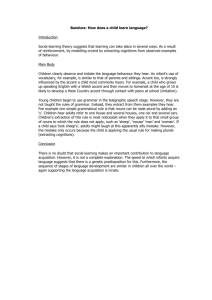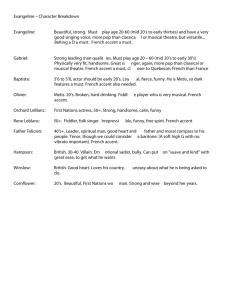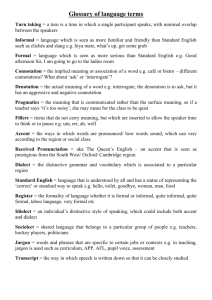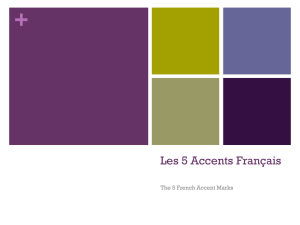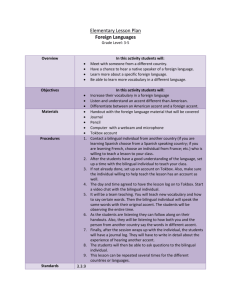The Deformity of Anti-Faithfulness
advertisement
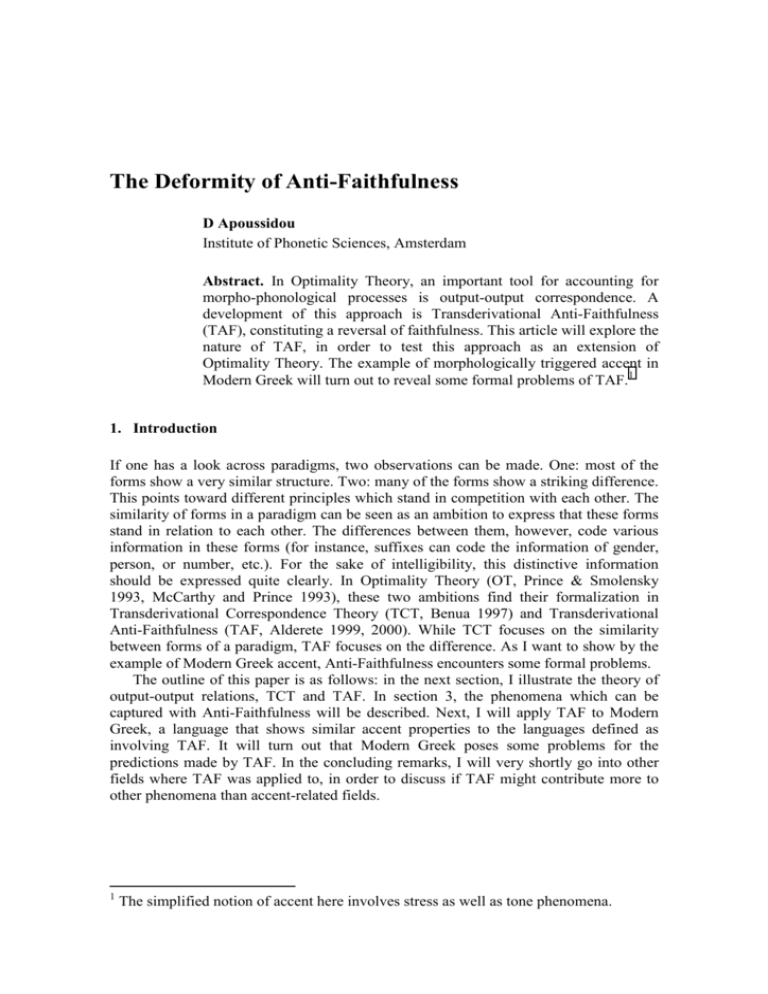
The Deformity of Anti-Faithfulness D Apoussidou Institute of Phonetic Sciences, Amsterdam Abstract. In Optimality Theory, an important tool for accounting for morpho-phonological processes is output-output correspondence. A development of this approach is Transderivational Anti-Faithfulness (TAF), constituting a reversal of faithfulness. This article will explore the nature of TAF, in order to test this approach as an extension of Optimality Theory. The example of morphologically triggered accent in Modern Greek will turn out to reveal some formal problems of TAF.1 1. Introduction If one has a look across paradigms, two observations can be made. One: most of the forms show a very similar structure. Two: many of the forms show a striking difference. This points toward different principles which stand in competition with each other. The similarity of forms in a paradigm can be seen as an ambition to express that these forms stand in relation to each other. The differences between them, however, code various information in these forms (for instance, suffixes can code the information of gender, person, or number, etc.). For the sake of intelligibility, this distinctive information should be expressed quite clearly. In Optimality Theory (OT, Prince & Smolensky 1993, McCarthy and Prince 1993), these two ambitions find their formalization in Transderivational Correspondence Theory (TCT, Benua 1997) and Transderivational Anti-Faithfulness (TAF, Alderete 1999, 2000). While TCT focuses on the similarity between forms of a paradigm, TAF focuses on the difference. As I want to show by the example of Modern Greek accent, Anti-Faithfulness encounters some formal problems. The outline of this paper is as follows: in the next section, I illustrate the theory of output-output relations, TCT and TAF. In section 3, the phenomena which can be captured with Anti-Faithfulness will be described. Next, I will apply TAF to Modern Greek, a language that shows similar accent properties to the languages defined as involving TAF. It will turn out that Modern Greek poses some problems for the predictions made by TAF. In the concluding remarks, I will very shortly go into other fields where TAF was applied to, in order to discuss if TAF might contribute more to other phenomena than accent-related fields. 1 The simplified notion of accent here involves stress as well as tone phenomena. 2. Output-Output Relations While TCT (Benua 1997) accounts for similarities between morphologically related forms, TAF on the other hand is meant to account for the differences between morphologically related forms. 2.1 Transderivational Correspondence TCT is an extension of OT that puts two output forms into correspondence with each other. With this approach, it is possible to explain the similarity between the forms of a paradigm. This is achieved through Output-Output-Faithfulness. The two corresponding strings are a base and a derivative form. Consider stress placement in English, where stress can stay in the same position, as shown in (1). The output forms párent and párenthood stand in connection with their input morphemes /parent/ and /-hood/, but they also stand in correlation with each other. OO-Faithfulness requires that these two outputs should be phonologically identical.2 So in (1), stress is in both forms realized on the same syllable in both forms. (1) English: párent - párenthood OO-Faith Output: Input: [párent] IO-Faith ↑ /parent/ → [párenthood] ↑ IO-Faith /parent+hood/ 2.2 Transderivational Anti-Faithfulness Conversely, English morphologically related forms can also differ in their stress positions. Consider for instance verbs and nouns that are much the same regarding their segments, but that differ in their stress placement. A word like record is stressed on the initial syllable if it is a noun (récord), and stressed on the final syllable if it is a verb (recórd). Morpho-accentual processes like these can serve to strengthen the opposition between two morphological classes (2). (2) récord (N) – recórd (V) Anti-Faith Output: Input: [récord] IO-Faith ↑ /record/ → [recórd] ↑ IO-Faith /record/ This opposition is in TAF expressed by means of Anti-Faithfulness constraints. This constraint class enforces the contrast between two morphologically related outputs, namely between a base and a related morphological derivative form. Anti-Faithfulness 2 In this example, OO-Faithfulness refers only to accent placement. So the fact that the derivative form has more structure than the base, namely the segments /h/, /o:/, and /d/, and thus would violate a constraint like OO-DEP-STRUCTURE, is ignored here for the sake of simplicity. constitutes a reversal of traditional Faithfulness, but is restricted to output-output relations. While Faithfulness as such seeks to maintain identity between two corresponding strings (3+4), Anti-Faithfulness is defined as requiring a difference in some respect (5). (3) General Faithfulness (McCarthy and Prince 1995) MAXIMALITY: Every element of S1 has a correspondent in S2. DEPENDENCE: Every element of S2 has a correspondent in S1. (4) OO-correspondence (Benua 1997) OO-FAITH-X: Every element of the derivative form has a correspondent in the base, and vice versa. (5) Anti-Faithfulness (Alderete 1999): For every Faithfulness constraint F, there is a corresponding Anti-Faithfulness constraint ¬F that is satisfied in a string S iff S has at least one violation of F. A more detailed definition is given in (6): (6) Anti-Faithfulness constraints (Alderete 2000): ¬MAX-X: ¬ [∀x ∃x’ [x ∈ S1 → x’ ∈ S2 & xRx’] ] ‘If there is one, delete (at least) one X in the S1 → S2 mapping.’ ¬DEP-X: ¬ [∀x ∃x’ [x ∈ S2 → x’ ∈ S1 & xRx’] ] ‘Insert (at least) one X in S2 not present in S1.’ ¬IDENT(F): ¬ [∀y ∀y’ ∀F [ yRy’ → y =F y’ ] ] ‘(At least) one pair of correspondent segments must differ in feature F.’ Translating that into constraints restricting accent, ¬MAX-ACCENT brings about an obligatory deletion of accent. ¬DEP-ACCENT requires the insertion of an accent in the derivative form, where no accent was in the base (this accounts for pre- and postaccenting affixes); and last but not least, ¬IDENT(ACCENT) (Alderete 1999, ¬NOFLOP-PROM in Alderete 2000) causes an obligatory accent shift, because the accent of the derivative form should be in another position than in the base. Ranked in the following way, the different accentual processes can be captured schematically (7). (7) Schematic rankings: a) ¬OO-MAX-ACCENT >> OO-MAX-ACCENT → Accent Deletion b) ¬OO-DEP-ACCENT >> OO-DEP-ACCENT → Pre-/Post-Accentuation c) ¬OO-IDENT-ACCENT >> OO-IDENT-ACCENT → Accent Shift 3. Accentual processes involving AF TAF was developed, among other things such as a reversal in voicing specification in Luo (Gregersen 1972, Alderete 1999, 2000), for accentual phenomena such as accent deletion, pre- and postaccentuation, and accent shift. These accentual processes are mainly due to interactions between morphemes. Morphologically triggered accent can be said to involve lexical markings in that morphemes can be specified for accent in the lexicon. Morphemes can thus be self-accenting (they carry an accent themselves), preand postaccenting (they assign accent on the preceding or following morpheme/syllable), or they can trigger an accent shift (the accent stays on the original morpheme, but switches to another vocalic peak). Since it is generally the case that languages only realize one main accent per word, a conflict is predicted in situations where two inherently accented morphemes are combined to form a word. There are several ways to solve such a conflict. One possibility is to choose the accent that is close to a designated edge of a word (coded in the grammar in the form of alignment constraints, for instance). Another possibility is to give some of the morphemes a dominant status, in opposition to the others. The conflict is then solved in favour of the specification of the dominant morpheme. With TAF, these conflicts are solved in terms of anti-output-output correspondence. While a similarity between related forms is due to OO-correspondence, a dissimilarity between such forms is due to a principle that requires a difference to make clear the diverse morphological status of the forms. So, in derived environments, such as paradigms, where each entry might code additional information, a difference between forms can not only be expressed through addition of structure, but also through alternation of already existing structure (i.e. accent deletion or insertion). As a result, a distinction between root-controlled accent and affixcontrolled accent emerges (Alderete 1999, 2000). In languages with root-controlled accent (i.e. Cupeño, Hill and Hill 1968), roots as well as affixes can possess a lexical specification for accent. If a specified root and a specified affix are combined, the root accent overrides the accent of the affix. These languages resemble the general tendency of a cross-linguistically observable ranking of RootFaith above AffixFaith (McCarthy & Prince 1995). In opposition to that are systems with affix-controlled accent, where affixes can be the dominant morphemes and trigger accent. So a reversal of AffixFaith over RootFaith can be observed. This reversal is accounted for by TAF in that it requires the opposite of Faithfulness. To classify a system as root-controlled or affix-controlled, several criteria have to be fulfilled. In order to be classified as being root-controlled, a system has to be methodically faithful to the root properties. To be classified as affix-controlled, affix faithfulness has to outrank root faithfulness in at least some cases, that is, some affixes have to be dominant, while others can be recessive, in the sense that accent conflicts are solved in favour of dominant affixes, but not in favour of recessive ones. In affixcontrolled systems, affix morphemes generally display more contrast in their specifications, in the sense that e.g. roots as well as affixes can be inherently accented, but that only affixes can be also pre- or postaccenting. In TAF, this is expressed by the principle of Strict Base Mutation (Alderete 1999, 2000), which requires that affixcontrolled processes always affect an element of the base of a morphological process. So in affix-controlled systems, it should for instance not be the case that a root can override affix properties, in the sense that there are no pre- or postaccenting roots. In the following section, I want to apply TAF to Modern Greek, a language whose accent system involves accentual conflicts resulting in accent deletion, pre- and postaccentuation. It will turn out that TAF cannot satisfyingly account for the attested accent pattern. But first, I will present some properties of Modern Greek. 4. TAF analysis of Modern Greek 4.1. Modern Greek – the data Modern Greek is a language with fusional morphology, where affixation is the common process of word formation. Generally, a word consists of a root and an inflectional suffix. Derivational suffixes can be inserted between root and inflection. These morphemes can be lexically marked with certain accent properties. Roots can be specified for accent, and for being postaccenting, that is posing the accent on the following morpheme. Inflectional suffixes can be specified for accent, and for being preaccenting. Derivational suffixes can be specified for accent, but also for pre- or postaccenting (in these classifications, I follow Revithiadou 1999). The language allows only one main accent per word, so the morphemes of a word can compete with each other regarding accent assignment. It appears that there seems to be a hierarchy: Derivational morpheme >> root morpheme >> inflectional morpheme. If only root and inflection are combined, it is always the root accent that appears on the surface (8a, c, f, g), except if the root is not inherently accented (8d, e). Only then can an inflectional affix maintain its lexical specification on the surface (8e). If the inflection is not inherently specified, a phonological default is assigned to the antepenultimate syllable (if the word contains three or more syllables, like in (8d); if there are less syllables, accent is assigned to the initial syllable). When a (lexically specified) derivational suffix is added, root as well as inflectional accent is overridden (8b). The affixes can thus be subdivided into dominant and recessive morphemes. (8) Distribution of accent in Modern Greek a) /stafíδ/root + /a/infl → stafíδa b) /stafíδ/root + /ák/deriv + /i/infl → stafiδáki c) /klívan/root + /os/infl → klívanos → ánθropos d) /anθrop/root + /os/infl e) /anθrop/root + ‘/u/infl → anθrópu f) /uran/’root + /os/ → uranós + ‘/u/infl → uranú g) /uran/’root ‘grape-Nom-Sg’ ‘grape-Nom-Sg-Dim’ ‘kiln-Nom-Sg’ ‘man-Nom-Sg’ ‘man-Gen-Sg’ ‘sky-Nom-Sg’ ‘sky-Gen-Sg’ From these data, we can already note a problem with the typology TAF requires: Modern Greek does involve postaccenting roots (8f, g), that is, roots are able to assign an accent to the following morpheme. In the next section, I demonstrate how TAF can be applied to Modern Greek, and where it fails to account for the facts. To keep it short, I will limit my discussion on self-accented and postaccenting roots, dominant selfaccented and recessive preaccenting suffixes. There are also accentless and selfaccented recessive suffixes, as well as pre- and postaccenting dominant suffixes (Revithiadou 1999), to be complete, but the forms mentioned in (8) will be sufficient to explain the difficulty. 4.2. Modern Greek – root-controlled or affix-controlled? Since the Modern Greek accent system employs both dominant and recessive affixes, the language can be classified as having affix-controlled accent. Besides, pre- and postaccentuation is also involved. So some of the ranking of (7) should be found in Modern Greek, namely ¬OO-MAX-ACCENT >> OO-MAX-ACCENT for the dominance effects and ¬OO-DEP-ACCENT >> OO-DEP-ACCENT for the occurrence of pre-and postaccentuation. To account for the fact that there are dominant and recessive affixes, the Anti-Faithfulness constraints have to be split into ¬OODom-MAX-ACCENT and ¬OORec-MAX-ACCENT, respectively. ¬OORec-MAX-ACCENT is ranked below OO-MAXACCENT and IO-MAX-ACCENT, because recessive affixes do not override root accent. Let us first consider the case in Modern Greek, when a root is combined with a dominant self-accented affix: /stafiδ-ák-i/. A candidate pair like in (9a) violates the Anti-Faithfulness constraint referring to the dominant morpheme -ak- (¬OODom-MAXACC), because the accent of the base is not deleted. A candidate pair like that in (9b), where no accent is realized, does not violate ¬OODom-MAX-ACC, because this constraint requires a deletion of the accent in the base part, which is fulfilled in this candidate. But this candidate is worse than (9c), because it has one more violation of IO-MAX-ACCENT, so candidate (9c) surfaces as optimal.3 (9) stafíδa - stafiδáki4 Base: /stafíδ/+/ákiDom/ a. stafíδa b. stafíδa ! c. stafíδa stafíδaki stafiδaki stafiδáki ¬OODomMAX-ACC *! OO-MAX-ACC IO-MAX-ACC * * * **! * Anti-Faithfulness would even account for the case where a root and a recessive preaccenting inflectional suffix are combined (10): accent remains on the root (10d) because the added suffix is recessive. Since no dominant affixes are involved in (10), ¬OODom-MAX-ACC is not violated at all, so it was spared from the tableau. The positive counterpart, OO-MAX-ACC, is violated in candidate pair (10b) as well as in pair (10c) because in both cases the accent of the base is deleted. Candidate (10b) looks like candidate (10a), but it gets its accent from the inflection. IO-MAX-ACC is violated in (10b+c), because the specification of the root has been deleted. Note that in candidate (10a), not the accent of the root is deleted, but rather shifted to the right. This is a violation of high-ranked IDENTITY (Beckmann 1997), which requires that correspondents are the same. The candidate pair (10d) on the other hand only violates the constraint referring to the recessive inflection. Remember that ¬OORec-DEP-ACC is the constraint that causes an insertion of an accent on the base, and thus is responsible for preaccentuation. (10) Base: a. klívanos b. klívanos c. klívanos ! d. klívanos klívanos - klívanu /klí1van/+’2/uRec/ klivá1nu klivá2nu klivanu klívanu OOIDENT *! OO-MAXACC IO-MAXACC *(!) *(!) *(!) *(!) ¬OORecDEP-ACC * * * However, if you take the output-output pair ánθropos - anθrópu into consideration and compare it with the pair in (10), a formal problem arises. Since both klívanos and 3 In Modern Greek, there are also other constraints involved in accentuation. Nevertheless, the focus is here on the interaction between the constraints referring to dominant and recessive morphemes, and the conflict between lexical specifications of these morphemes. I will come back to the other constraints in my own analysis later on. 4 The suffix -aki- consists, strictly speaking, of the derivation -ak- and the inflection -i, but since the inflection is no point of interest here, I contract both morphemes and treat them as a unit. ánθropos serve as a base, they both have already been assigned accent. So you would expect the same results when the preaccenting suffix -u gets attached. But, in one case accent remains on the original position of the base (klívanu), while in the other the accent is realized in pre-position of the inflection (anθrópu). According to TAF and the ranking established in (9) and (10), accent should be realized on the same position in the ánθropos - anθrópu pair as in klívanos – klívanu, namely on the base. But this is not the case, as (11) shows. ¬OODom-MAX-ACC is not of interest here because no dominant affixes are involved, so it is left out of the tableau. The candidate pair (11c) is a loser, because it violates OO-MAX-ACCENT in the sense that the accent of the base is deleted and another accent is assigned elsewhere. This candidate also violates ¬OORec-DEPACC, since it has an accent on the inflection, rather than being preaccenting. But this is not crucial here. The candidate pair in (11a) wins according to TAF because it has only one violation of low-ranked ¬OORec-DEP-ACC, but instead, (11b) should win (because that is the attested form in Modern Greek), although it violates general OO-MAXACCENT, since the accent of the base is deleted and an accent is assigned by the inflection. Thus, according to Anti-Faithfulness, candidate (11a) should win, but in fact, candidate (11b) is attested in Modern Greek. ánθropos - anθrópu /anθrop/+’/uRec/ OO-MAXACC " a. ánθropos ánθropu # b. ánθropos anθrópu *! c. ánθropos anθropú *! (11) Base: IO-MAX-ACC ¬OORec-DEPACC * * One could think of a repair strategy, specificially to subdivide OO-MAX-ACC, which requires faithfulness to the base, into a dominant and a recessive constraint, so that the dominant constraint is fulfilled in a case like (10), and that the recessive version of this constraint is ranked below ¬OORec-DEP-ACC, so that it is fulfilled in a case like (11). Yet, this would be contradictory to the prediction of TAF, namely Strict Base Mutation, which says that in an output-output relation only the base can be affected. The principle of SBM derived out of the observation that affixes show more variation in their properties than roots in affix-controlled systems. The affixes can not only be ±accented, but also ±dominant and also pre- and postaccenting. Roots on the other hand show according to Alderete (1999, 2000) cross-linguistically only up as ±accented. One conclusion out of that is, if roots assign accent, it is not due to dominance, but due to the systematic emergence of RootFaith >> AffixFaith. Roots might then realize their inherent specification only when combined with a recessive affix. In opposition to that stands Modern Greek, where you would have to distinguish between dominant and recessive roots, where AffixDom >> RootDom >> AffixRec >> RootRec. The reason why forms like anθrópu and klívanu behave differently is that they are accented on the antepenultimate syllable due to different principles. A root like klivanis lexically specified for accent, so in cases where lexically specified morphemes are involved, IO-Faithfulness is responsible for accent assignment. A root like anθrop- is lexically unmarked and thus does not fall under the scope of IO-Faithfulness. Accent in ánθropos is assigned to the antepenultimate syllable by way of a phonological default (Malikouti-Drachman & Drachman 1989, Revithiadou 1999). Anti-Faithfulness constraints have no impact on this difference in roots, since they only compare outputs with each other, and have no impact on input structure. Furthermore, Modern Greek has poststressing roots (8f, g), similar to the ones observable in Russian. While postaccenting roots in Russian were analysed by Alderete as not having a lexical specification, but being the default due to (a positive Faithfulness) constraint POST-STEM-ACCENT (Alderete 2000), this analysis cannot be transferred to Modern Greek. Post-root accent is definitely not the default accent position in the language. The default position is the antepenultimate syllable (if a word is three or more syllables long, else accent is placed on the initial syllable; MalikoutiDrachman & Drachman 1989, see Revithiadou 1999 for an OT analysis), which in OT terms can be expressed with constraints like NONFINALITY and constraints referring to foot structure. Postaccenting roots must have a lexical specification for accent, else they could not assign stress to the succeeding morpheme (which they clearly do in cases like 8f and g). Therefore, I would like to propose another approach to the Greek data. The conflict between the lexical specifications of roots and affixes can be solved without OOFaithfulness, if one assumes that the lexical accent is coded as partial foot structure (Revithiadou 1999, Apoussidou 2002; Inkelas 1998 on full foot structure as lexical specifications). In that case, IO-Faithfulness constraints referring to the strong part of a foot (self-accenting and postaccenting morphemes) or to the weak part of a foot (preaccenting morphemes) are required. I will sketch this approach shortly below5, starting with the default accent of a word like ánθropos. In this case, no lexical specification is involved. Constraints involved are TROCHEE (since Modern Greek is a trochaic language), FOOTBINARITY, NONFINALITY (in the sense of Tesar and Smolensky, 2000, that is the final syllable of a word should not be footed; this constraint is responsible for extrametricality), and ALIGN-FOOTRIGHT (that prevents four or more syllable words from being accented on the initial syllable). The candidates (12a) and (12b) are both ruled out, because they both violate the constraint responsible for extrametricality; also, candidate (12b) violates FTBINARITY. Candidate (12a) is the winner, because it only violates low-ranked ALIGNFT-R. (12) ánθropos /anθrop/+/os/ ! a. (ánθro)pos b. an(θrópos) c. anθro(pós) TROCHEE FTBIN NONFIN *(!) *! *(!) ALIGN-FT-R * As soon as at least one lexical specification for accent is involved, the phonological default is overridden. Thus, the constraints referring to the lexical specifications are higher ranked than the constraints that assign the default accent. This is demonstrated in (13). A constraint MAX-FOOTweak requires the lexical specification in form of a weak part of a foot to surface (in this case, the specification of the inflectional suffix). IDENTITY requires the lexical specification to surface on the morpheme that is marked for it. Candidate (13a) now violates high-ranked IDENTITY, since the specification of the suffix is realized elsewhere in the word, and not on the inflection itself. Candidate (13c) violates MAX-FOOTweak because the specification does not surface as weak, but on the contrary is realized as strong, that is, the preaccenting suffixes is realized as accented. Candidate (13b) is optimal, since it violates neither of the higher ranked constraints. 5 See Apoussidou 2002 for a more elaborate analysis of Modern Greek accent. (13) anθrópu /anθrop/+/u)/ MAX-FOOTstrong a. (ánθro)pu ! b. an(θrópu) c. anθro(pú) *! IO-IDENTITY *! FTBIN NONFIN * * * Similarly, if a morpheme is specified for a strong part of a foot, a constraint MAXFOOTstrong requires that the specification surfaces (14). A candidate that contains an accent shift is ruled out by IDENTITY (14b), while a candidate without any accent would violate MAX-FTstrong (14c). A candidate like (14a) is optimal, since it is faithful in any respect. (14) klívanos /(klivan/+/os/ MAX-FTstrong ! a. (klíva)nos b. kli(vános) c. klivanos *! IO-IDENTITY FTBIN NONFIN *! * In (15), a conflict between two specifications is shown. It can be solved through establishing a ranking order between the two faithfulness constraints MAX-FTstrong and MAX-FTweak, so the candidate that realizes the strong specification of a foot (15a) wins. A candidate like (15c) is suboptimal, since it violates both faithfulness to the specification as well as to the position of the specification. (15) klívanu /(klivan/+/u)/ MAX-FTstrong ! a. (klíva)nu b. kli(vánu) *! c. kliva(nú) MAX-FTweak IO-IDENTITY * * *!* FTBIN NONFIN * * * Postaccenting roots can be regarded as having a specification for a strong part of a foot as well, and this specification is linked to the final segment of the root. Then, the analysis looks like the ones for words like klívanos and klívanu. Still, in cases where an accented derivational suffix is added, a distinction has to be made between dominant and recessive faithfulness (Revithiadou 1999), since then neither faithfulness to the kind of specification nor to the position of the specification can solve the conflict. Furthermore, one could argue that Russian has also postaccenting roots in form of a lexical specification. If one assumes that the default accent is on the leftmost syllable in a word (like e.g. Revithiadou, 1999, does), then postaccenting roots in Russian would pose the same problems to TAF as Modern Greek does. 5. Conclusion While TAF might be applied quite successfully to featural changes in OO-relations (values for the feature voice in Luo, Alderete 1999, 2000; Turkish reduplication, Kelepir 1999), it is not the adequate instrument to account for accent phenomena, since it cannot distinguish between differences in bases. Also, there are some formal problems: how can a constraint, which is sensitive to output-output relations, have access to lexical specifications of morphemes? Lexical specifications are only accessible via input-output faithfulness. Other theoretical approaches might deal with the same issues in a somehow better way, for instance Realizational Morphology Theory (RMT, Kurisu 2001), where differences in morphologically related forms is due to addition of information (which may not necessarily be realised in addition of structure, but also in distraction of structure). Questions remain to what extent attempts to restrict Anti-Faithfulness to morphology (i.e. Horwood 2002) could improve this approach. References Alderete J 1999 Morphologically Governed Accent in Optimality Theory. Doctoral Dissertation (Amherst: Univ. of Massachusetts) 2000 Dominance Effects as Transderivational Anti-Faithfulness. ROA Nr 407 Apoussidou D 2002 Unpredictable Accent Patterns in Correspondence Theory. SFB282-Paper Nr. 120 (Düsseldorf: Heinrich-Heine-Univ.) Benua L 1997 Transderivational Identity: Phonological Relations between Words. Doctoral Dissertation (Amherst: Univ. of Massachusetts) Gregersen E A 1972 Consonant Polarity in Nilotic. In E Voeltz (ed) Third Ann. Conf. on African Linguistics (Bloomington: Indiana Univ.) Hill J and Hill K 1968 Stress in the Cupan (Uto-Aztecan) Languages. Intern. Journal of American Linguistics 34 p 233-241 Horwood G 2002 Anti-Faithfulness and Subtractive Morphology. ROA Nr 466 Inkelas S 1998 Exceptional stress-attracting suffixes in Turkish: representations versus the grammar. In The Prosody-Morphology Interface Kelepir M 1999 Turkish emphatic reduplication and antifaithfulness. Proc. ConSole VII p 153-167 Kurisu K 2001 The phonology of morpheme realization. Doctoral Dissertation (Santa Cruz: Univ. of California) Malikouti-Drachman A and Drachman G 1989 Stress in Greek [Tonismos sta Ellinika]. Studies in Greek Linguistics 1989 (Univ. of Thessaloniki) p 127-143 McCarthy J and Prince A 1993 Prosodic Morphology I: Constraint Interaction and Satisfaction. Rutgers Center for Cognitive Science (RuCCS) Technical Report 3 (Amherst: Univ. of Massachussetts, and Rutgers Univ.) McCarthy J and Prince A 1995 Faithfulness and Reduplicative Identity. ROA Nr 600000 Prince A and Smolensky P 1993 Optimality Theory: Constraint interaction in Generative Grammar. Ms. (Rutgers Univ. and Univ. of Colorado at Boulder) Revithiadou A 1999 Headmost Accent Wins. Head Dominance and Ideal Prosodic Form in Lexical Accent Systems. The Hague: Holland Academic Graphics Tesar B and Smolensky P 2000 Learnability in Optimality Theory (Cambridge, London: MIT Press) Beckmann J 1997 Positional Faithfulness. Doct. Dissertation (Amherst: Univ. of Massachussetts)
